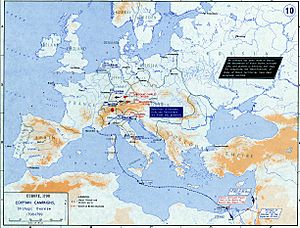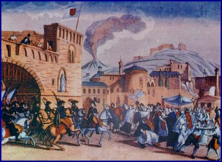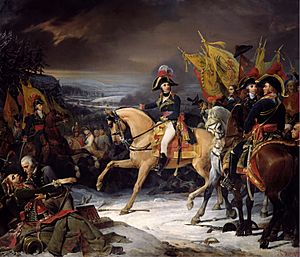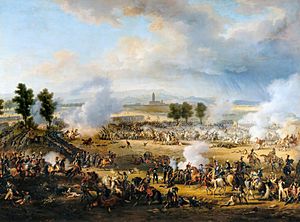War of the Second Coalition facts for kids
Quick facts for kids War of the Second Coalition |
|||||||||
|---|---|---|---|---|---|---|---|---|---|
| Part of the French Revolutionary Wars and the Coalition Wars | |||||||||
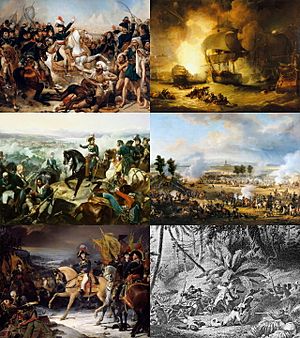 Click an image to load the appropriate article. Left to right, top to bottom: Battles of the Pyramids, the Nile, Zurich, Marengo, Hohenlinden, the Haitian Revolution |
|||||||||
|
|||||||||
| Belligerents | |||||||||
|
Second Coalition: |
|
||||||||
| Commanders and leaders | |||||||||
|
|
||||||||
| Casualties and losses | |||||||||
140,000 captured |
140,000 captured |
||||||||
The War of the Second Coalition was a major conflict between the new French Republic and many European kingdoms. It lasted from 1798 or 1799 until 1801 or 1802. The main countries fighting against France were Britain, Austria, and Russia. Other nations like the Ottoman Empire, Portugal, and Naples also joined. Spain supported France.
The main goals of Britain and Russia were to stop France from expanding its power and to bring back the monarchy in France. Austria wanted to regain its strength and lands lost in earlier wars. Because the allied countries had different goals, the Second Coalition could not defeat the French Republic. France kept the lands it had gained since 1793.
In February 1801, France and Austria signed the Treaty of Lunéville. France kept all its previous gains and got new lands in Tuscany, Italy. Austria received Venetia and parts of Venetian Dalmatia. Most other allies also made peace with France in 1801. Britain and France signed the Treaty of Amiens in March 1802. This brought a short period of peace in Europe. However, fighting started again in May 1803, leading to the War of the Third Coalition.
Contents
How the War Started
On April 20, 1792, France declared war on Austria. This started the War of the First Coalition (1792–1797). In this war, France fought against most of its neighbors, including Great Britain, Portugal, and Prussia. At first, the Coalition forces won some battles. But eventually, they were pushed out of France. France then took over many territories and set up "client republics." These were new countries that were controlled by France.
Napoleon Bonaparte led successful campaigns in Italy. He pushed back Austrian forces and signed peace treaties. After these treaties, Britain was left fighting alone against France, Spain, and the Netherlands.
A Short Break in Fighting
From October 1797 to March 1799, France and Austria avoided direct fighting. However, they remained suspicious of each other. France demanded more land than what was agreed upon in the peace treaty. The Habsburgs (Austrian rulers) did not want to give up their lands.
Other events also increased tensions. In the summer of 1798, Napoleon led an army to Egypt and Syria. On his way, he stopped at Valletta, the capital of Hospitaller Malta. The ruler of Malta, Grand Master Ferdinand von Hompesch zu Bolheim, only allowed two ships in the harbor at a time. Napoleon ignored this rule and attacked Valletta. French troops landed and took over the island. This angered Emperor Paul I of Russia, who was the honorary head of the Order of Malta.
Also, the French government believed Austria was planning another war. The weaker France seemed, the more Austria, Naples, Russia, and Britain discussed forming a new alliance. Napoleon's army got stuck in Egypt. He returned to France in October 1799, but his army in Egypt surrendered in September 1801.
Preparing for War
French military leaders knew that the areas around the Rhine River, southern Germany, and Switzerland were very important for defending France. The mountain passes in Switzerland allowed armies to move quickly between northern Italy and Germany. The army that controlled these passes had a big advantage.
In late 1798, Marshal Jean-Baptiste Jourdan took command of French forces near the Rhine. His job was to "observe" the French border. He found his army was not ready for a fight. They lacked soldiers, supplies, and training. Most resources were sent to other French armies. Jourdan wrote many letters to the French government about these problems. But his requests for more soldiers and supplies were mostly ignored.
Jourdan's orders were to move his army into Germany. He needed to secure important roads, especially near Stockach and Schaffhausen. Another French general, André Masséna, was in charge of the army in Switzerland. He was ordered to take control of key passes like the St. Gotthard Pass and the area around Zürich. These positions would stop the enemy from moving troops easily between Italy and Germany. This would also allow France to control all western roads leading to Vienna.
Forming the Second Coalition
It took several months for the Second Coalition to form.
- Naples joined Austria on May 19, 1798, and Russia on November 29.
- British Prime Minister Pitt and Austrian Chancellor Thugut tried to get Prussia to join, but it refused.
- Britain and Austria did not sign a formal alliance. They worked together without a full agreement.
- Russia allied with the Ottoman Empire on December 23 and Great Britain on December 26. Russia also attacked French-controlled islands.
- By December 1, the Kingdom of Naples had signed alliances with both Russia and Great Britain.
The first military action happened on November 29. General Karl Mack, an Austrian working for Naples, took over Rome. He wanted to bring back the Pope's rule. King Ferdinand of Naples was encouraged by his wife, Queen Maria Carolina, and by British Admiral Horatio Nelson. However, the Neapolitan army was poorly equipped and led. They were quickly defeated outside Rome. On January 23, France occupied Naples itself. The king, British officials, and the queen had to escape to Sicily.
The War Begins
1799: Early Battles
In Europe, the allied forces launched several attacks. These included campaigns in Italy and Switzerland, and a joint British-Russian invasion of the Netherlands. The Russian general Alexander Suvorov won many battles against the French in Italy. He pushed them back towards the Alps.
However, the allies were less successful in other areas. The British and Russians had to retreat from the Netherlands after a defeat at Castricum. In Switzerland, an Austrian-Russian army was completely defeated at the Second Battle of Zurich. These losses, along with Britain's actions against Russian ships in the Baltic Sea, caused Russia to leave the Coalition.
Meanwhile, Napoleon invaded Syria from Egypt. But he had to retreat after failing to capture Acre. He then defeated a British-Turkish invasion. When he heard about political problems in France, he returned home. He used his popularity and army support to take power in a coup. He became First Consul, the leader of the French government.
1800: Napoleon's Return
Napoleon sent General Moreau to fight in Germany. Napoleon himself gathered a new army at Dijon. He marched his troops through Switzerland to attack the Austrian armies in Italy from behind.
Moreau invaded Bavaria and won a major victory against Austria at the Battle of Hohenlinden. He continued marching towards Vienna, and the Austrians asked for peace. This led to the Armistice of Steyr on December 25.
In May 1800, Napoleon led his troops across the Alps through the Great St. Bernard Pass into Italy. He fought against the Sardinian and Austrian armies at the Siege of Fort Bard for two weeks. After this, he was able to enter Italy. He narrowly defeated the Austrians at the Battle of Marengo. The Austrians had a much larger army. But Napoleon managed to organize a quick retreat and then returned with more soldiers. The French cavalry successfully attacked the Austrian side. Napoleon then negotiated for Austria to leave Piedmont, Liguria, and Lombardy.
1801: Peace Treaties
Before July/August 1800, Ireland was a separate kingdom with its own parliament. It was linked to Great Britain through the Crown. After a rebellion in 1798, Ireland became part of the United Kingdom of Great Britain and Ireland on January 1, 1801.
The Austrians signed the Armistice of Treviso on January 16, ending the war in northern Italy. On February 9, they signed the Treaty of Lunéville for the entire Holy Roman Empire. This treaty mostly accepted the terms of an earlier peace agreement. In Egypt, the Ottomans and British invaded. They forced the French to surrender after taking Cairo and Alexandria.
Britain continued fighting at sea. A group of neutral countries, including Prussia, Russia, Denmark-Norway, and Sweden, formed a coalition. They wanted to protect their ships from Britain's blockades. This led to Admiral Nelson's surprise attack on the Danish fleet at the Battle of Copenhagen.
France and Spain invaded Portugal in the War of Oranges. This forced Portugal to sign the Treaty of Badajoz (1801). Russia officially made peace with France through the Treaty of Paris on October 8. They also signed a secret alliance two days later.
In December 1801, France sent an army to Saint-Domingue (now Haiti) to take back the island. The island had been independent since the Haitian Revolution in 1791. This mission was a disaster. Over 30,000 French troops, including many experienced soldiers, died from diseases like yellow fever by the end of 1802. Napoleon's brother-in-law, General Charles Leclerc, was among them.
What Happened Next
On March 25, 1802, Britain and France signed the Treaty of Amiens. This ended Britain's involvement in the war. After an earlier treaty in Paris on October 9, 1801, the Treaty of Paris on June 25, 1802, ended the war between France and the Ottoman Empire. The Ottoman Empire was the last remaining member of the Second Coalition.
These peace treaties gave the left bank of the Rhine River to France. They also recognized the independence of the Cisalpine, Batavian, and Helvetic republics (countries controlled by France). This began the longest period of peace between 1792 and 1815. This treaty is often seen as the point where the French Revolutionary Wars ended and the Napoleonic Wars began. However, Napoleon was not crowned emperor until 1804.
See Also


